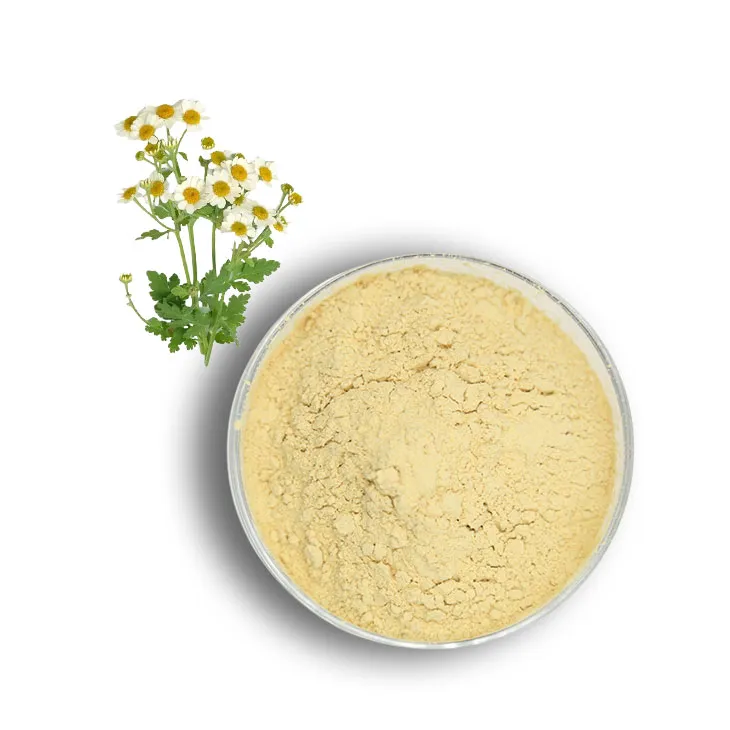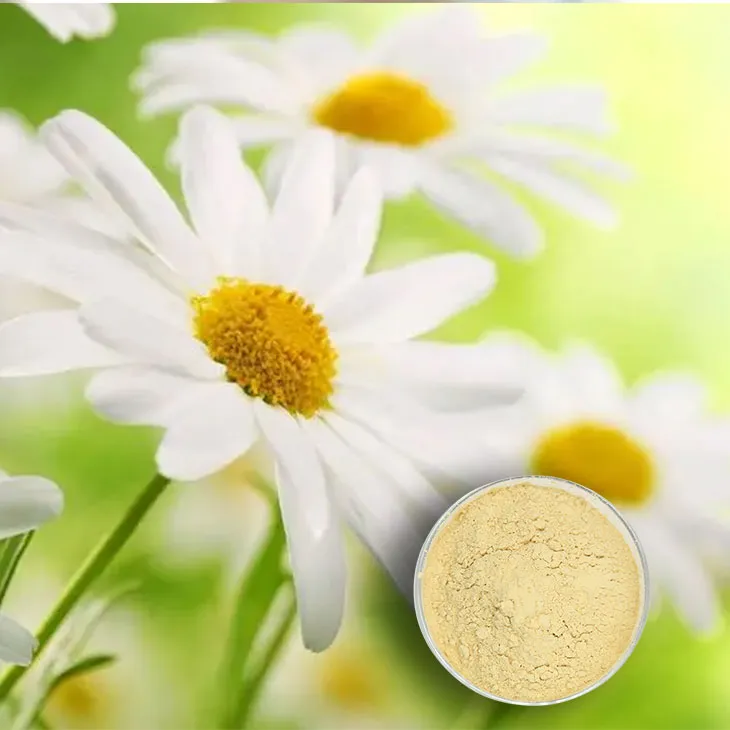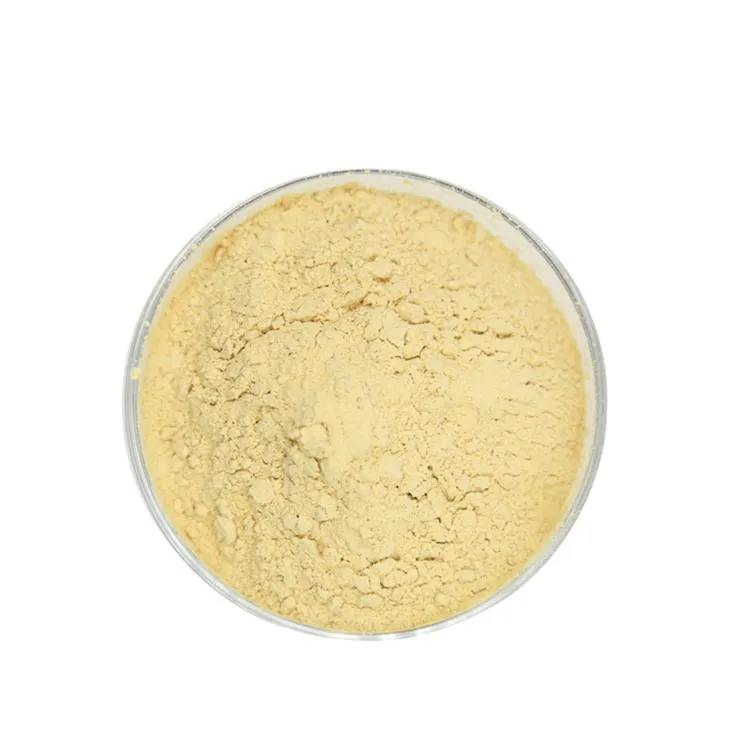- 0086-571-85302990
- sales@greenskybio.com
The process of extracting parthenolide from feverfew extract.
2024-11-26

1. Introduction
Feverfew (Tanacetum parthenium) has been known for its medicinal properties for centuries. One of the most important bioactive compounds found in feverfew is parthenolide. Parthenolide has attracted significant attention due to its potential therapeutic applications in the medical field. Extracting parthenolide from Feverfew Extract is a crucial step in harnessing its benefits. This article will delve into the details of this extraction process, including different extraction methods, quality control, and its applications.

2. Solvent Extraction
2.1. Principle
Solvent extraction is one of the most commonly used methods for extracting parthenolide from feverfew. The principle behind this method is based on the solubility of parthenolide in a particular solvent. Different solvents can be used depending on their ability to dissolve parthenolide while leaving other unwanted components behind.
2.2. Commonly Used Solvents
- Ethanol: Ethanol is a popular solvent for parthenolide extraction. It has several advantages. Firstly, it is relatively safe to handle compared to some other solvents. It can dissolve parthenolide to a reasonable extent. However, it may also extract some other compounds along with parthenolide, which may require further purification steps. - Hexane: Hexane is another solvent that can be used. It is non - polar and is good at dissolving non - polar compounds like parthenolide. The advantage of hexane is that it can selectively extract parthenolide from the Feverfew Extract. But hexane is highly flammable and poses safety risks during handling.
2.3. Procedure
1. The feverfew plant material is first dried and ground into a fine powder. This increases the surface area available for extraction. 2. The powdered material is then soaked in the selected solvent. The ratio of the plant material to the solvent is an important factor and is usually optimized based on experimental trials. 3. The mixture is stirred or shaken for a specific period, usually several hours to ensure proper extraction. 4. After extraction, the mixture is filtered to separate the solid residue from the solvent containing parthenolide. 5. The solvent is then evaporated, either under reduced pressure or at a specific temperature, to obtain the parthenolide - rich extract.
2.4. Limitations
- Solvent extraction may not be very selective in some cases, leading to the co - extraction of other compounds. This can increase the complexity of the purification process. - The use of organic solvents may have environmental and safety concerns. Some solvents are volatile and can contribute to air pollution if not properly handled.

3. Supercritical Fluid Extraction
3.1. Principle
Supercritical fluid extraction (SFE) utilizes a supercritical fluid, most commonly carbon dioxide (CO₂), as the extracting agent. A supercritical fluid has properties between those of a liquid and a gas. It has a high diffusivity like a gas and can dissolve substances like a liquid. CO₂ is preferred because it is non - toxic, non - flammable, and easily available.
3.2. Procedure
1. The feverfew sample is placed in an extraction vessel. 2. The CO₂ is pressurized and heated above its critical point (critical temperature = 31.1 °C and critical pressure = 73.8 bar) to form a supercritical fluid. 3. The supercritical CO₂ is passed through the feverfew sample, and parthenolide is dissolved in the supercritical fluid. 4. The mixture of supercritical CO₂ and parthenolide is then passed through a separator where the pressure is reduced. This causes the CO₂ to return to its gaseous state, leaving the parthenolide behind.
3.3. Advantages
- High Selectivity: SFE can be highly selective in extracting parthenolide. It can avoid the co - extraction of many unwanted compounds, reducing the need for extensive purification steps. - Environmentally Friendly: Since CO₂ is used as the solvent, which is a natural gas, it is more environmentally friendly compared to organic solvents. There are no harmful emissions during the extraction process. - Product Quality: The parthenolide obtained through SFE is often of higher quality as it is less likely to be degraded or contaminated during the extraction process.
3.4. Limitations
- The equipment for supercritical fluid extraction is expensive. This high cost can be a barrier for small - scale operations or research laboratories with limited budgets. - The process requires precise control of pressure and temperature conditions. Any deviation from the optimal conditions can affect the extraction efficiency.

4. Quality Control during the Extraction Process
4.1. Purity Analysis
One of the most important quality control measures is to determine the purity of the extracted parthenolide. This can be done using various analytical techniques such as high - performance liquid chromatography (HPLC). HPLC can separate and quantify parthenolide in the extract, allowing for the detection of any impurities.
4.2. Identification of Compounds
In addition to purity analysis, it is essential to identify all the compounds present in the extract. Techniques like gas chromatography - mass spectrometry (GC - MS) can be used. GC - MS can provide detailed information about the chemical composition of the extract, helping to ensure that the extraction process is selective and that only the desired parthenolide is being extracted.
4.3. Monitoring of Extraction Conditions
- During solvent extraction, factors such as temperature, extraction time, and solvent - to - sample ratio need to be carefully monitored. Any variation in these conditions can affect the yield and purity of parthenolide. - In supercritical fluid extraction, precise control of pressure and temperature is crucial. Monitoring devices should be in place to ensure that these conditions are maintained within the optimal range throughout the extraction process.

5. Potential Applications of Parthenolide in the Medical Field
5.1. Anti - Inflammatory Properties
Parthenolide has been shown to possess significant anti - inflammatory properties. It can inhibit the activation of certain inflammatory pathways, such as the NF - κB pathway. This makes it a potential candidate for the treatment of inflammatory diseases like arthritis. By suppressing inflammation, parthenolide may help reduce pain and swelling in affected joints.
5.2. Anti - Cancer Activity
- There is growing evidence suggesting that parthenolide has anti - cancer properties. It can induce apoptosis (programmed cell death) in cancer cells. For example, in leukemia cells, parthenolide has been shown to disrupt the cell cycle and promote cell death. - Parthenolide may also have the ability to inhibit angiogenesis, the formation of new blood vessels that tumors need to grow and metastasize. This anti - angiogenic effect can potentially limit the growth and spread of cancer.
5.3. Neuroprotective Effects
Some studies have indicated that parthenolide may have neuroprotective effects. It may be able to protect neurons from oxidative stress and neurodegenerative diseases. For instance, in models of Alzheimer's disease, parthenolide has been shown to reduce the accumulation of amyloid - β plaques, which are characteristic of the disease.

6. Conclusion
The extraction of parthenolide from Feverfew Extract is a complex but important process. Different extraction methods, such as solvent extraction and supercritical fluid extraction, each have their own advantages and limitations. Quality control during the extraction process is crucial to ensure the purity and quality of the extracted parthenolide. The potential applications of parthenolide in the medical field are vast, including anti - inflammatory, anti - cancer, and neuroprotective effects. Further research is needed to optimize the extraction process and fully explore the therapeutic potential of parthenolide.
FAQ:
Question 1: What are the main solvent extraction methods for parthenolide from feverfew extract?
Solvent extraction can involve using organic solvents like ethanol or methanol. Ethanol is often preferred as it is relatively safe and can effectively dissolve parthenolide from the feverfew extract. The process typically involves soaking the feverfew in the solvent for a period, followed by filtration and concentration to obtain the parthenolide - rich extract. However, solvent extraction may also extract other unwanted compounds along with parthenolide, which can be a limitation.
Question 2: What are the advantages of supercritical fluid extraction for parthenolide?
Supercritical fluid extraction has several advantages. It uses substances like carbon dioxide in a supercritical state. One major advantage is its selectivity, which can often result in a purer parthenolide extract compared to solvent extraction. It is also more environmentally friendly as carbon dioxide is non - toxic and can be easily removed from the final product. Additionally, it can operate at relatively low temperatures, which helps preserve the integrity of parthenolide as it is less likely to be degraded compared to extraction methods that use high temperatures.
Question 3: What are the limitations of supercritical fluid extraction?
The main limitations of supercritical fluid extraction include the high cost of equipment required for the process. The setup for supercritical fluid extraction is complex and expensive, which may not be affordable for all laboratories or industries. Also, the extraction efficiency may be affected by factors such as pressure and temperature control, and it may require more optimization compared to traditional solvent extraction methods.
Question 4: How can the quality of parthenolide extraction be controlled?
Quality control during parthenolide extraction can be achieved through several methods. Firstly, the selection of raw materials, i.e., high - quality feverfew, is crucial. Analytical techniques such as high - performance liquid chromatography (HPLC) can be used to monitor the purity and quantity of parthenolide throughout the extraction process. Standard operating procedures should be followed precisely to ensure consistent results. Additionally, controlling factors like extraction time, temperature, and solvent - to - sample ratio can also contribute to the quality control of the extraction process.
Question 5: What are the potential medical applications of parthenolide?
Parthenolide has several potential medical applications. It has shown anti - inflammatory properties, which can be useful in treating various inflammatory diseases such as arthritis. It also has anti - cancer potential as it can induce apoptosis in cancer cells and inhibit tumor growth. Additionally, parthenolide may have applications in the treatment of neurodegenerative diseases due to its antioxidant and anti - inflammatory effects, which can help protect neurons from damage.
Related literature
- Optimization of Parthenolide Extraction from Feverfew Using Response Surface Methodology"
- "Supercritical Fluid Extraction of Parthenolide: A Green and Efficient Approach"
- "The Role of Parthenolide in Inflammatory and Cancer Diseases: A Review"
- ▶ Hesperidin
- ▶ Citrus Bioflavonoids
- ▶ Plant Extract
- ▶ lycopene
- ▶ Diosmin
- ▶ Grape seed extract
- ▶ Sea buckthorn Juice Powder
- ▶ Fruit Juice Powder
- ▶ Hops Extract
- ▶ Artichoke Extract
- ▶ Mushroom extract
- ▶ Astaxanthin
- ▶ Green Tea Extract
- ▶ Curcumin
- ▶ Horse Chestnut Extract
- ▶ Other Product
- ▶ Boswellia Serrata Extract
- ▶ Resveratrol
- ▶ Marigold Extract
- ▶ Grape Leaf Extract
- ▶ New Product
- ▶ Aminolevulinic acid
- ▶ Cranberry Extract
- ▶ Red Yeast Rice
- ▶ Red Wine Extract
-
Cocoa Extract
2024-11-26
-
Apricot Powder
2024-11-26
-
Uridine-5'-monophosphate Disodium salt
2024-11-26
-
Feverfew Extract
2024-11-26
-
White Peony Extract
2024-11-26
-
Nettle leaf extract
2024-11-26
-
Rosemary extract
2024-11-26
-
Avocado Extract Powder
2024-11-26
-
Tinospora cordifolia extract
2024-11-26
-
Rose Hip Extract
2024-11-26




















